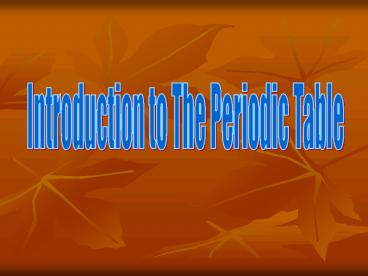Introduction to The Periodic Table - PowerPoint PPT Presentation
1 / 16
Title:
Introduction to The Periodic Table
Description:
Around 90 elements occur naturally while others are made artificially. ... P - reactive non-metal. S reactive non-metal. Cl Very reactive non-metal. Ar noble gas ... – PowerPoint PPT presentation
Number of Views:260
Avg rating:3.0/5.0
Title: Introduction to The Periodic Table
1
Introduction to The Periodic Table
2
Introduction
- More than 110 elements are known.
- Around 90 elements occur naturally while others
are made artificially. - Elements vary greatly in their physical and
chemical properties.
3
Father of the Periodic Table
- Demitri Mendeleev ( Russian Chemist)
4
- Mendeleev arranged the elements in order of
atomic mass. - Then he observed similar chemical and physical
properties appear at regular, or periodic
intervals.
5
The Modern Periodic Table
- In modern periodic table, the elements are
arranged in order of atomic number and electron
configuration.
6
Periodic Law
- The properties of the elements are periodic
function of their atomic number.
7
Periodic Table
8
Arrangements of the Periodic table
- Period the horizontal rows of the table.
- The period number is the number of energy levels
in which electrons occupy in the atom of an
element.
9
Groups / Families
- Groups the vertical columns of the table.
- Each member of a given group contains the same
number of valence electron.
10
Valence electrons
- The electrons in the outer energy levels of an
atom. - e.g. 2-8-7
- valence electrons
- The last number in the electron configuration
11
- Across a period, the properties of elements
change systematically. - Na very reactive metal
- Mg reactive metal
- Al - less reactive metal
- Si - metalloid
- P - reactive non-metal
- S reactive non-metal
- Cl Very reactive non-metal
- Ar noble gas
12
- Elements in the same group have similar
properties because it is the number of valence
electrons that determines the chemical properties
of the element.
13
Special Groups
- Group 1 Alkaline metals
- Group 2 Alkaline earth metals
- Group 17 Halogens
- Group 18 Noble gases
- Groups 3-12 - Transition metals
14
Ions
- Ions are charge particles while atoms are
neutral. - There are two types of ions.
- 1. Positive ions Cations
- 2. Negative ions - Anions
15
Formation of Ions
- Cations cations are formed when metals lose
electrons. - E.g. Na (2-8-1) Na (2-8) e
- Anions Anions are formed when non-metals gain
electrons. - E.g. Cl (2-8-7) e Cl (2-8-8)
16
(No Transcript)































